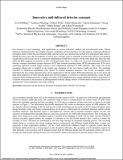Files in this item
Innovative mid-infrared detector concepts
Item metadata
| dc.contributor.author | Höfling, Sven | |
| dc.contributor.author | Pfenning, Andreas | |
| dc.contributor.author | Weih, Robert | |
| dc.contributor.author | Ratajczak, Albert | |
| dc.contributor.author | Hartmann, Fabian | |
| dc.contributor.author | Knebl, Georg | |
| dc.contributor.author | Kamp, Martin | |
| dc.contributor.author | Worschech, Lukas | |
| dc.contributor.editor | Strojnik, Marija | |
| dc.date.accessioned | 2017-01-25T10:30:16Z | |
| dc.date.available | 2017-01-25T10:30:16Z | |
| dc.date.issued | 2016-09-14 | |
| dc.identifier | 248904616 | |
| dc.identifier | a90402c8-0afc-4a19-9a3a-46fe4f8bbe5c | |
| dc.identifier | 85008512349 | |
| dc.identifier | 000390265000005 | |
| dc.identifier.citation | Höfling , S , Pfenning , A , Weih , R , Ratajczak , A , Hartmann , F , Knebl , G , Kamp , M & Worschech , L 2016 , Innovative mid-infrared detector concepts . in M Strojnik (ed.) , Infrared Remote Sensing and Instrumentation XXIV . , 997306 , Proceedings of SPIE , vol. 9973 , SPIE , Infrared Remote Sensing and Instrumentation XXIV , San Diego , United States , 29/08/16 . https://doi.org/10.1117/12.2237270 | en |
| dc.identifier.citation | conference | en |
| dc.identifier.isbn | 9781510603370 | |
| dc.identifier.issn | 0277-786X | |
| dc.identifier.uri | https://hdl.handle.net/10023/10169 | |
| dc.description.abstract | Gas sensing is a key technology with applications in various industrial, medical and environmental areas. Optical detection mechanisms allow for a highly selective, contactless and fast detection. For this purpose, rotational-vibrational absorption bands within the mid infrared (MIR) spectral region are exploited and probed with appropriate light sources. During the past years, the development of novel laser concepts such as interband cascade lasers (ICLs) and quantum cascade lasers (QCLs) has driven a continuous optimization of MIR laser sources. On the other hand side, there has been relatively little progress on detectors in this wavelength range. Here, we study two novel and promising GaSb-based detector concepts: Interband cascade detectors (ICD) and resonant tunneling diode (RTD) photodetectors. ICDs are a promising approach towards highly sensitive room temperature detection of MIR radiation. They make use of the cascading scheme that is enabled by the broken gap alignment of the two binaries GaSb and InAs. The interband transition in GaSb/InAs-superlattices (SL) allows for normal incidence detection. The cut-off wavelength, which determines the low energy detection limit, can be engineered via the SL period. RTD photodetectors act as low noise and high speed amplifiers of small optically generated electrical signals. In contrast to avalanche photodiodes, where the gain originates from multiplication due to impact ionization, in RTD photodetectors a large tunneling current is modulated via Coulomb interaction by the presence of photogenerated minority charge carriers. For both detector concepts, first devices operational at room temperature have been realized. | |
| dc.format.extent | 10 | |
| dc.format.extent | 2354579 | |
| dc.language.iso | eng | |
| dc.publisher | SPIE | |
| dc.relation.ispartof | Infrared Remote Sensing and Instrumentation XXIV | en |
| dc.relation.ispartofseries | Proceedings of SPIE | en |
| dc.subject | Gas sensing | en |
| dc.subject | Interband cascade detector | en |
| dc.subject | Mid-IR | en |
| dc.subject | Resonant tunneling diode | en |
| dc.subject | QC Physics | en |
| dc.subject | TK Electrical engineering. Electronics Nuclear engineering | en |
| dc.subject | Electronic, Optical and Magnetic Materials | en |
| dc.subject | Condensed Matter Physics | en |
| dc.subject | Computer Science Applications | en |
| dc.subject | Applied Mathematics | en |
| dc.subject | Electrical and Electronic Engineering | en |
| dc.subject | NDAS | en |
| dc.subject.lcc | QC | en |
| dc.subject.lcc | TK | en |
| dc.title | Innovative mid-infrared detector concepts | en |
| dc.type | Conference item | en |
| dc.contributor.institution | University of St Andrews. School of Physics and Astronomy | en |
| dc.contributor.institution | University of St Andrews. Condensed Matter Physics | en |
| dc.identifier.doi | 10.1117/12.2237270 |
This item appears in the following Collection(s)
Items in the St Andrews Research Repository are protected by copyright, with all rights reserved, unless otherwise indicated.

